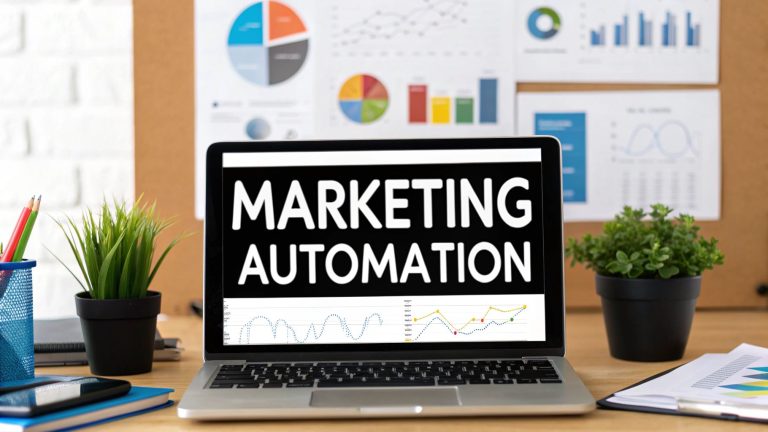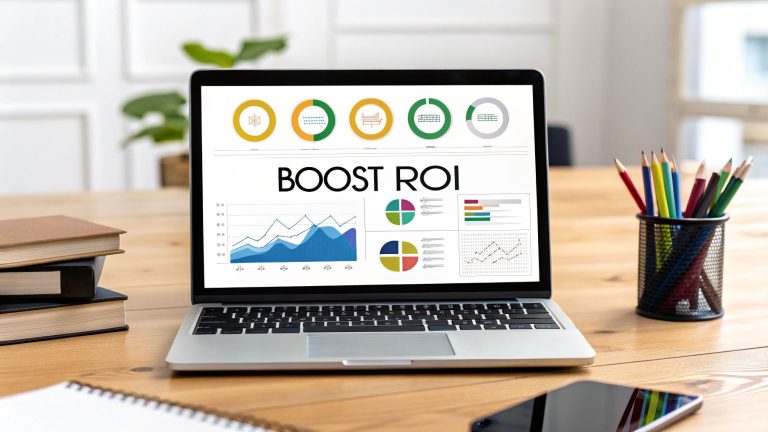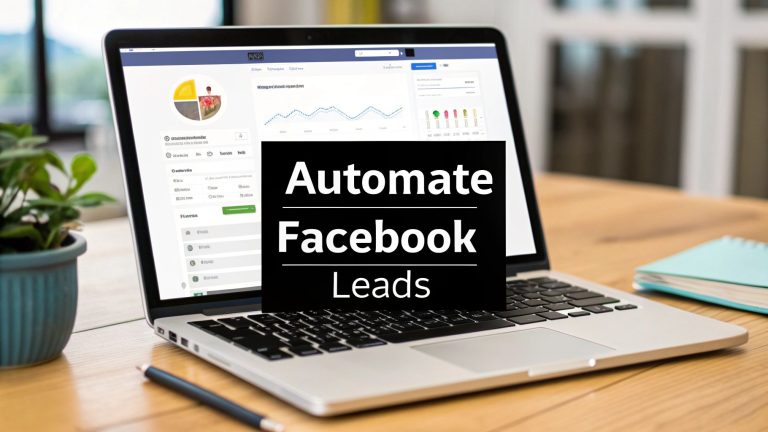What is Multichannel Marketing? Strategies & Examples
At its core, multichannel marketing is a strategy where a company uses several different, independent channels to connect with customers.
Think of it like a band promoting their next big tour. They’ll run ads on the radio, drop posts on social media, and slap up posters around town. Each channel works on its own, aiming to catch the attention of a different slice of their fanbase. The whole point is to give people more ways to find and engage with you.
Decoding the Multichannel Approach

To really get what multichannel marketing is all about, you have to accept that your customers aren't all hanging out in one spot. They're everywhere—scrolling through social media, checking their email, walking into your physical store, or browsing your website. This strategy is about showing up on several of these channels to cast the widest net possible.
The defining feature here is that the channels operate in parallel. They don't have to be perfectly synced up. A customer might see a promotional post on Facebook, get a completely different newsletter in their inbox, and then spot another offer when they visit you in-store. Each interaction is a standalone touchpoint, designed to maximize your brand's visibility and give customers plenty of ways to connect.
The Customer Is in Control
This approach puts the customer firmly in the driver's seat. They get to pick the channel they prefer for browsing, asking questions, and ultimately, making a purchase. For your business, this just means meeting people where they're already comfortable, which is a great way to smooth out the path to a sale.
Multichannel marketing isn't about crafting one perfectly unified customer journey. It's about opening up multiple, separate doorways and letting customers choose which one to walk through. The goal is simple: maximize your reach and be accessible.
Let’s look at how a clothing brand might put this into practice:
- Instagram: This is where they build hype. They’ll showcase new arrivals and share photos from happy customers to create a community and make the brand desirable.
- Email Marketing: They use email to talk directly to their loyal subscribers, sending out exclusive discount codes and sale alerts to drive repeat business.
- Physical Store: The brick-and-mortar location offers a full brand experience. Think personal styling advice and the instant gratification of walking out with a new outfit.
- Website: This is the central hub. It’s home to the entire product catalog, in-depth information, and, of course, the online checkout.
Each of these channels is a powerhouse on its own, built to achieve a specific goal. While the brand's voice stays consistent, the experience a customer has on Instagram is meant to be different from their experience with an email or in the store. By letting each channel play to its strengths, the brand massively broadens its overall reach and impact.
The Tangible Benefits of a Multichannel Approach
Going multichannel isn't just about getting your brand in front of more eyeballs; it's about driving real, measurable business results. The most immediate win is a massive boost in brand visibility. When you show up consistently across different platforms—from social feeds to email inboxes—you stay top-of-mind, building the kind of familiarity and trust that gets you noticed.
This constant presence has a direct impact on how customers behave. When people can connect with you on their preferred channels, you remove friction and make it incredibly easy for them to buy. That convenience is everything. In fact, a whopping 97% of consumers have bailed on a purchase simply because the process was inconvenient. It's no surprise the multi-channel marketing market is set to explode from $6.96 billion in 2023 to $28.6 billion by 2030.
Amplifying Conversions and Customer Insights
A smart multichannel strategy is basically a conversion machine. By meeting customers where they already hang out, you create more chances for them to take action. That could be clicking a link in an email, swiping up on an Instagram Story ad, or walking into your store after seeing a local promotion.
The core idea is simple: more touchpoints create more opportunities. Each channel acts as a new doorway for potential customers, increasing the likelihood they will step through and convert.
This infographic breaks down how a multichannel strategy directly fuels brand visibility, conversion rates, and the data you can collect along the way.
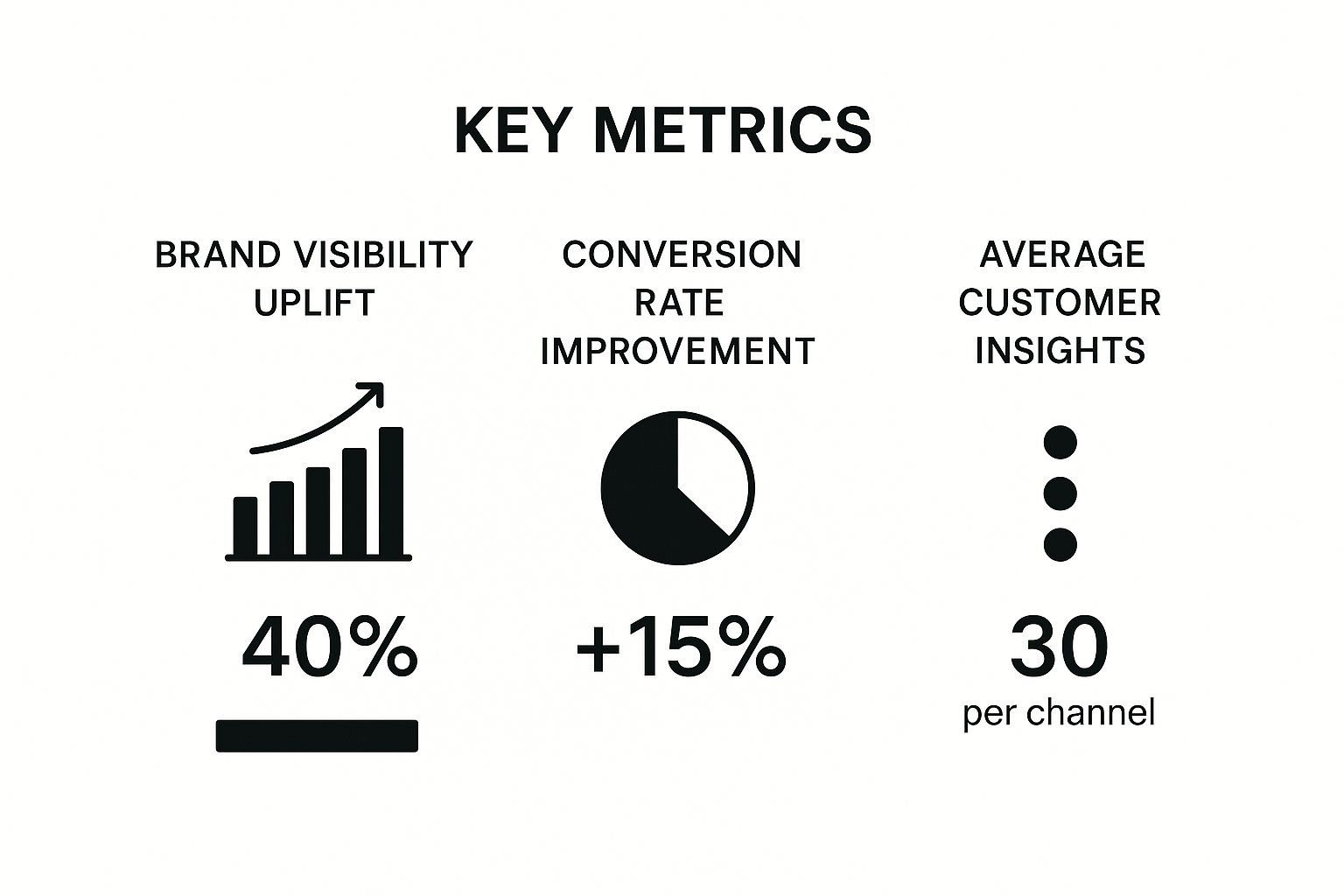
As you can see, expanding your presence doesn't just build awareness. It directly improves your ability to turn that attention into action.
Unlocking Deeper Data for Smarter Decisions
Beyond just sales, every channel you use is a valuable data-gathering tool, giving you unique clues about what your customers want. Think about it:
- Email marketing tells you exactly which headlines and offers make people click.
- Social media analytics reveal the content formats that get the most shares and comments.
- Website traffic data shows you which products or services people are most curious about.
When you piece all this diverse data together, you build a much richer, more accurate picture of your audience. These insights are pure gold for refining your marketing and making smarter, data-backed decisions. To truly grasp which channels are driving the most value, you'll want to get familiar with Attribution modeling.
Of course, tracking performance across so many platforms requires a solid system. Our guide on measuring marketing campaign effectiveness can show you how to connect all your efforts to real results. This helps you understand not just what's working, but why it is, allowing you to double down on your best channels for maximum impact and ROI.
Multichannel vs Omnichannel: The Critical Distinction
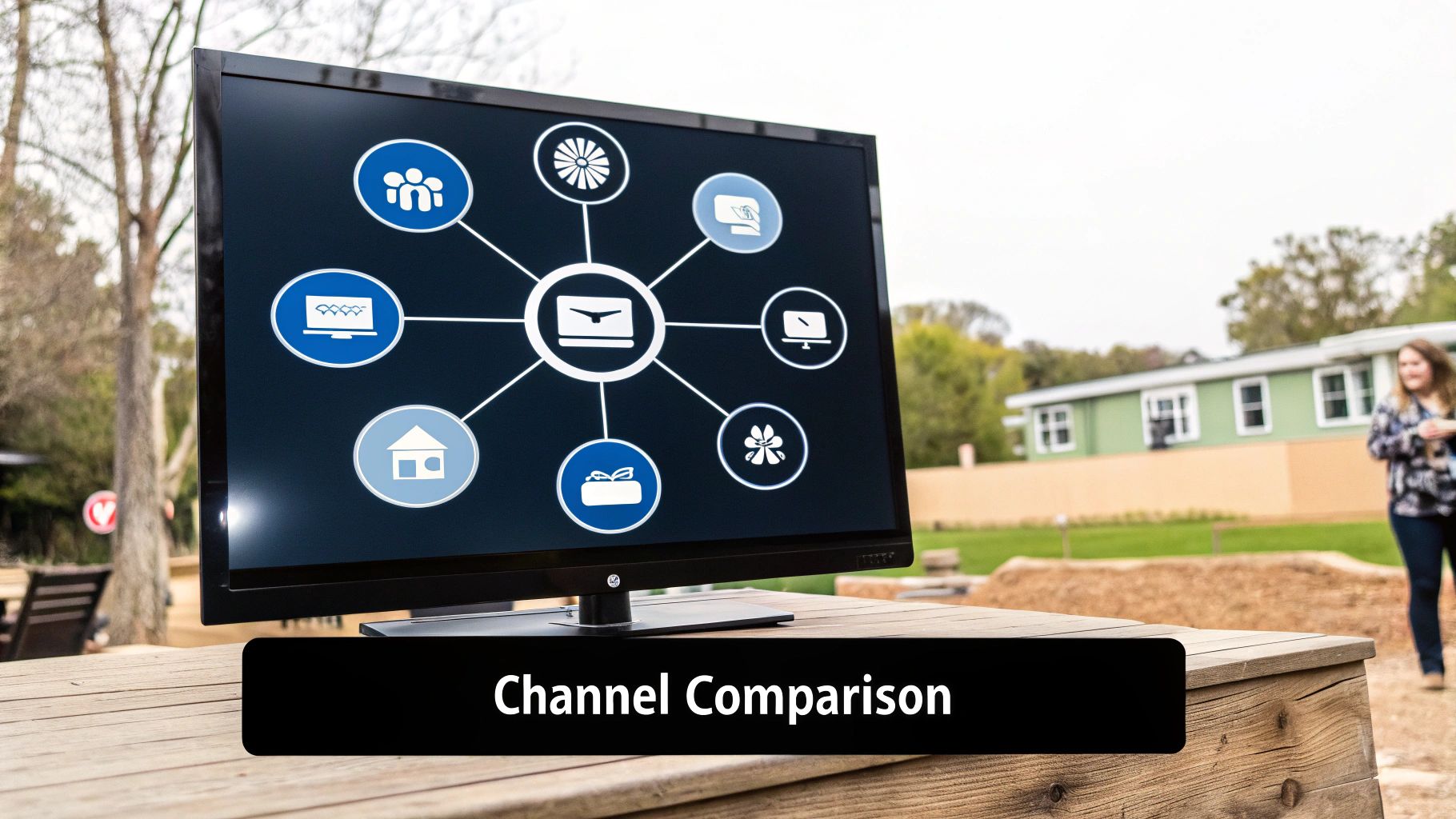
You’ll often hear the terms "multichannel" and "omnichannel" thrown around like they're the same thing. They're not. Getting this distinction right is key before you dive into building out your marketing strategy.
The real difference isn't about how many channels you use—it's about how those channels work together. Or if they work together at all.
Think of multichannel marketing like a wheel. Your brand is the hub in the middle, and each marketing channel—your email, your social media, your physical store—is a separate spoke reaching out to customers. Each one is a standalone touchpoint, and they don't connect with each other.
Someone’s experience on your Instagram feed is totally separate from their experience walking into your retail shop. The goal here is simple: be in as many places as possible to give customers different ways to find you.
The Omnichannel Alternative: A Web of Connectivity
Now, picture omnichannel marketing as a spider's web with the customer right in the center. Every channel is woven together, creating one single, seamless journey. The lines between your website, mobile app, and in-store visit basically disappear.
Here’s a real-world example: A customer browses a product on their laptop at home, adds it to their cart on their phone while on the train, and then pops into your store to see it in person. With an omnichannel setup, your store associate can pull up their online cart and finish the sale right there. It’s one fluid motion.
This approach is all about creating a unified experience, not just having a presence on different platforms.
The big shift is this: multichannel puts the brand at the center of its own channels. Omnichannel puts the customer at the center of everything, building an interconnected journey around them.
Comparing the Core Philosophies
The strategic mindset behind each approach is worlds apart. Multichannel is about casting the widest net possible. It's a game of volume and visibility, and success is usually measured by how well each individual channel performs on its own.
Omnichannel, on the other hand, is laser-focused on the quality and consistency of the customer’s entire journey. This requires some serious integration of data and tech to make sure a customer’s actions on one channel shape and improve their experience on the next. It’s built on the reality that modern buyers almost never stick to one neat, tidy path.
So, how do they really stack up? Let's break it down.
Multichannel vs Omnichannel at a Glance
This table cuts through the noise and gives you a side-by-side look at the core differences.
| Characteristic | Multichannel Marketing | Omnichannel Marketing |
|---|---|---|
| Primary Focus | Brand Presence | Customer Experience |
| Channel Integration | Channels are separate and operate independently. | Channels are fully integrated and work together. |
| Customer Journey | Disjointed; experience varies by channel. | Seamless; a single experience across all channels. |
| Data Usage | Data is typically siloed within each channel. | Data is shared across all channels to personalize the journey. |
| Goal | Maximize reach and engagement on each channel. | Create a unified, consistent, and effortless customer journey. |
Ultimately, the choice comes down to your business goals and resources. Multichannel is often a more accessible place to start. Omnichannel is the more advanced, customer-first evolution—but it demands a real investment in connecting all your systems.
Building Your Multichannel Marketing Strategy
Knowing what multichannel marketing is and actually doing it are two different things. A winning strategy isn't about showing up on every platform just because you can. It’s about being on the right platforms—the ones where your audience already lives and breathes.
The best place to start? Your own data. Before you start guessing, dive into your analytics and see where your customers are already hanging out. Are they clicking through from your emails? Are they loving your Instagram Stories? This is your roadmap. It tells you exactly where to focus your time and money for the biggest impact.
Define Your Channels and Set Clear Goals
Once you know where your people are, you need to decide why you're there. Every channel in your strategy needs a specific job. If you try to use every platform to make a hard sell, you'll just end up annoying your audience. A smart strategy uses different channels for different stages of the customer journey.
Think of it like this:
- Social Media (Instagram/TikTok): This is your brand's personality hub. Use it to build awareness, share behind-the-scenes content, and create a genuine community.
- Email Marketing: This is where you nurture relationships and drive sales. Think exclusive offers, personalized newsletters, and those all-important abandoned cart reminders.
- Content Marketing (Blog/YouTube): Your goal here is to become the go-to expert. Answer your audience's questions, solve their problems, and attract organic traffic by being genuinely helpful.
- Paid Advertising (Google/Facebook Ads): This is for precision targeting. Use paid ads to reach specific demographics with a clear call-to-action to generate high-quality leads and drive immediate sales.
When each channel has a purpose, they all work together without stepping on each other's toes. This coordinated approach is becoming essential. In fact, the global market for multi-channel marketing hubs hit around $6 billion in 2024 and is still climbing, all because businesses need better ways to create seamless customer experiences.
Maintain a Consistent Brand Voice
Even though your tactics will change from one channel to the next, your brand's personality shouldn't. Whether someone is reading your blog, seeing a tweet, or opening an email, they should instantly recognize your voice, visuals, and values.
Consistency builds trust. When your message feels familiar and reliable across all platforms, you create a stronger, more memorable brand that people can actually connect with.
This doesn't mean you should copy and paste the same message everywhere. It's about adapting your core message to fit the unique vibe of each platform while staying true to who you are.
Track Performance and Optimize Your Efforts
A multichannel strategy is never "set it and forget it." You have to keep a close eye on your Key Performance Indicators (KPIs) to see what's working, what's not, and where you need to make changes.
Start tracking these key metrics for each channel:
- Conversion rates
- Engagement levels (likes, comments, shares)
- Click-through rates from your emails and ads
- Website traffic coming from each source
Analyzing this data allows you to make smart decisions, like shifting your budget to the channels that are crushing it or tweaking your message on the ones that are falling flat. For e-commerce brands, choosing the right sales platform is a huge part of this; it's always smart to compare selling on Amazon vs Shopify to see which one aligns better with your goals.
To make all of this easier to manage, check out our guide on marketing automation for small businesses. It can help you keep your campaigns running smoothly across all your channels.
Multichannel Marketing Examples in the Real World
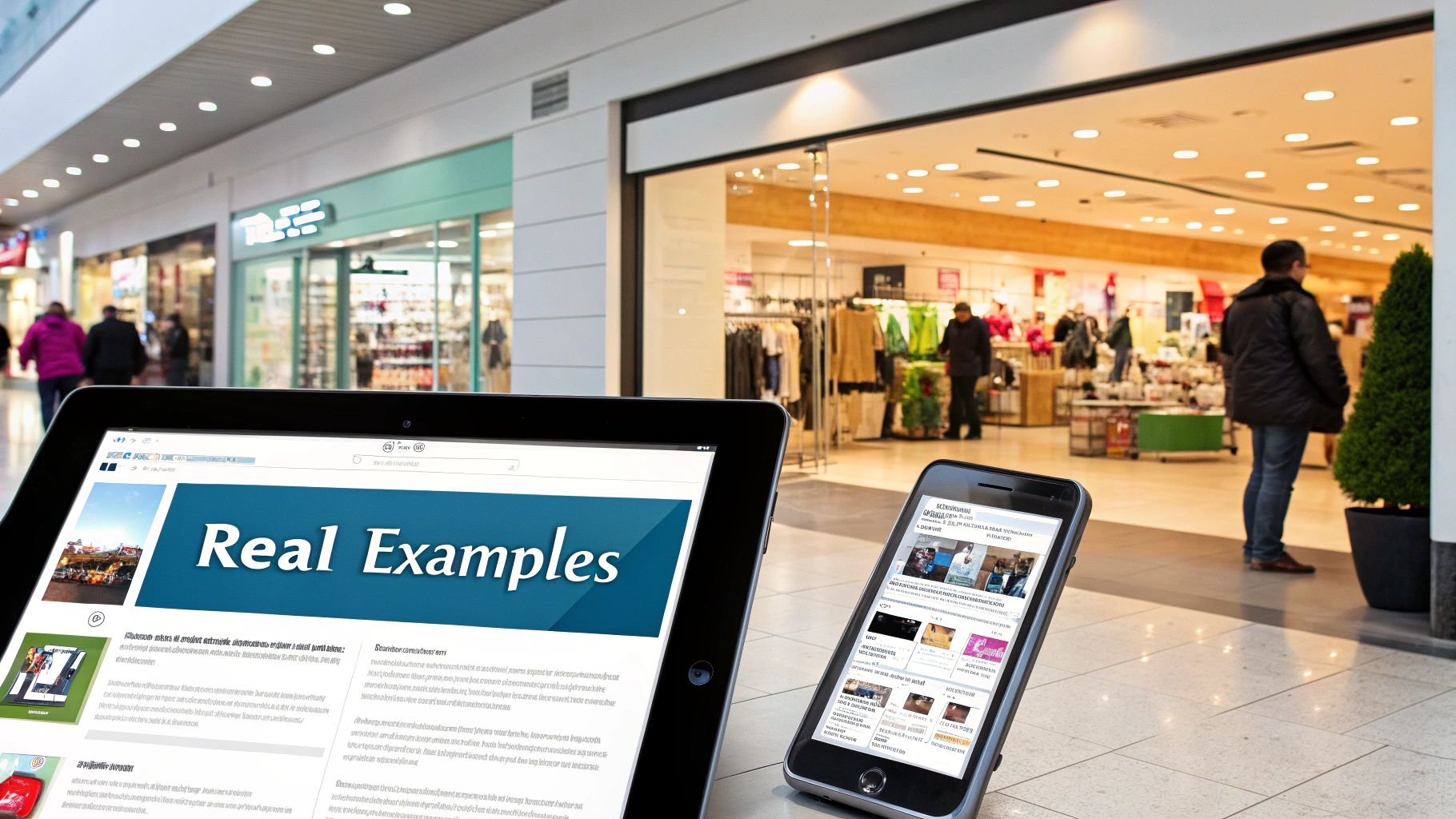
Theory is great, but seeing how multichannel marketing actually plays out in the real world is where it all clicks. The best brands aren't just showing up everywhere; they’re using each channel for a specific reason, giving customers options and casting the widest possible net.
By looking at how these companies pull it off, you can get a solid blueprint for your own strategy. It’s all about letting each channel do what it does best, while all of them work together to keep the audience engaged.
Retail Giants Mastering the Mix
Just look at a major retailer like Target. They put on a masterclass in using different channels for different jobs, all without losing that consistent brand feel. It's a textbook example of multichannel done right.
Here’s a glimpse into their playbook:
- Mobile App: The app is your best friend when you're in the store. It serves up digital coupons and makes it easy to check the weekly deals, directly improving the physical shopping experience.
- Email Marketing: Their newsletters are built to drive sales, plain and simple. Subscribers get the weekly ads, special promotions, and alerts when prices drop on stuff they’ve been eyeing.
- Social Media: On platforms like Instagram and Pinterest, Target sells a lifestyle. They show their products in cozy, real-world settings to build a community and nudge you toward a purchase without being pushy.
Each of these channels operates on its own, but they all push toward the same big goal: keeping customers hooked and moving products, whether online or in the aisle.
The B2B Software Playbook
The same logic applies perfectly to the B2B space. A software company, for example, can use a multichannel approach to guide prospects through a much longer sales cycle. Every channel is another opportunity to build trust.
The goal isn’t to force everyone down one rigid path. It's about creating multiple front doors. A B2B buyer might find you through a blog, connect on LinkedIn, and finally become a lead through a targeted ad—each touchpoint did its unique job.
Their strategy often looks something like this:
- Company Blog: This is where they establish themselves as the experts. By publishing deep-dive articles, case studies, and industry reports, they pull in valuable traffic from search engines.
- LinkedIn: The go-to spot for professional networking. They use it to share company updates, join industry conversations, and connect with potential buyers.
- Targeted Ads: They run ads on Google or LinkedIn to catch high-intent leads who are already looking for the exact solution they offer.
Social media is a huge piece of this puzzle for both B2C and B2B. With an estimated 5.42 billion global users expected by 2025, you can't afford to ignore it. People are active on an average of 6.8 different social platforms each month, so having a specific plan for each channel is non-negotiable.
Of course, a huge part of this is knowing how to turn that online buzz into real business. That means mastering effective lead generation on social media is critical to making your efforts pay off.
Trying to manage a multichannel marketing strategy can feel like you're spinning a dozen plates at once. You've got data coming in from email, social media, paid ads… and it's a total mess. It's almost impossible to know what's actually working when you're buried in spreadsheets.
This is exactly where you need a central command center to bring some sanity back to your workflow.
That’s what LeadSavvy Pro was built for. Forget manually downloading CSV files from Facebook or trying to stitch together a dozen different performance reports. Our platform is designed to be your single hub, pulling all your lead data from every campaign into one simple, clean dashboard.
A Single Source of Truth
By bringing everything together, we give you a clear, single source of truth. No more guesswork. You’ll know exactly which channels are bringing in the leads that actually turn into customers.
When all your lead data is consolidated, you can instantly see what's driving real results.
Having all your lead data in one place transforms a chaotic mess of channels into a measurable, cohesive strategy. This clarity is what lets you make smarter decisions and put your budget where it will actually make a difference.
LeadSavvy Pro also gives you a serious leg up with powerful automation. You can set up instant notifications for new leads and automatically sync them straight to your CRM or even a Google Sheet. This means your sales team can follow up in seconds while the lead is still hot.
Here’s a quick look at how it simplifies your marketing mix:
- Unified Dashboard: See and manage all your leads from every Facebook campaign without ever leaving LeadSavvy Pro.
- Workflow Automation: Stop wasting time on manual data entry. Automatically send leads right where they need to go.
- Consistent Messaging: With clean, organized data, you can make sure your follow-up is always timely and relevant, no matter where the lead came from.
At the end of the day, LeadSavvy Pro helps you run a much more efficient and measurable multichannel strategy. You'll save a ton of time and, more importantly, turn more of those hard-won leads into happy, loyal customers.
Got Questions About Multichannel Marketing?
Jumping into a multichannel strategy always brings up a few key questions. How in the world do you pick the right platforms? And how can you possibly measure what’s working when your efforts are spread all over the place? Let's tackle the big ones.
Honestly, one of the biggest hurdles is just figuring out where to begin. With countless options—from social media and email to paid ads and live events—it's easy to feel overwhelmed.
Which Marketing Channels Work Best Together?
There's no magic formula here, because the best mix is all about your audience and your goals. The real key is finding pairs that complement each other and naturally guide your customer along their journey.
For example, you could use a highly visual platform like Instagram to catch someone's eye and build brand awareness. Then, follow up with targeted email marketing to nurture that interest with a specific offer they can't refuse.
A killer approach is to pair an online channel with an offline one. Think about promoting a unique social media hashtag during a live event or webinar. The goal is to create a setup where you can see how each channel influences the other, helping you pinpoint the combinations that drive real results for your business.
How Do I Measure Multichannel Marketing Efforts?
This is where things can get tricky, but it boils down to one thing: attribution. You absolutely have to know which touchpoints are helping to close the deal. Most smart marketers are ditching the old "first-click" or "last-click" models and moving toward smarter systems that give credit to multiple channels along the way.
At the heart of good measurement is an attribution model everyone on your team agrees on. It’s the only way to accurately see what’s working, set realistic goals, and confidently double down on the channels that are actually making you money.
By keeping a close eye on metrics like conversion rates per channel, customer lifetime value, and engagement stats, you get a clear picture of your performance. This lets you stop guessing and start making informed tweaks to your strategy.
Ready to stop guessing and start unifying your lead data? LeadSavvy Pro brings all your leads into a single, clean dashboard, giving you the clarity to make smarter decisions, fast. Start for free at LeadSavvy Pro and see what you've been missing.


